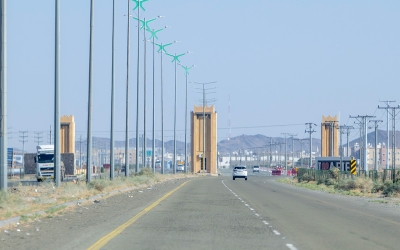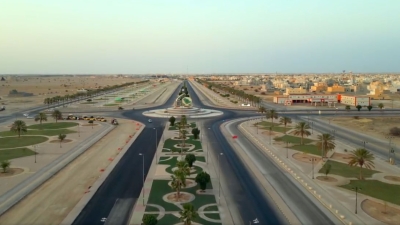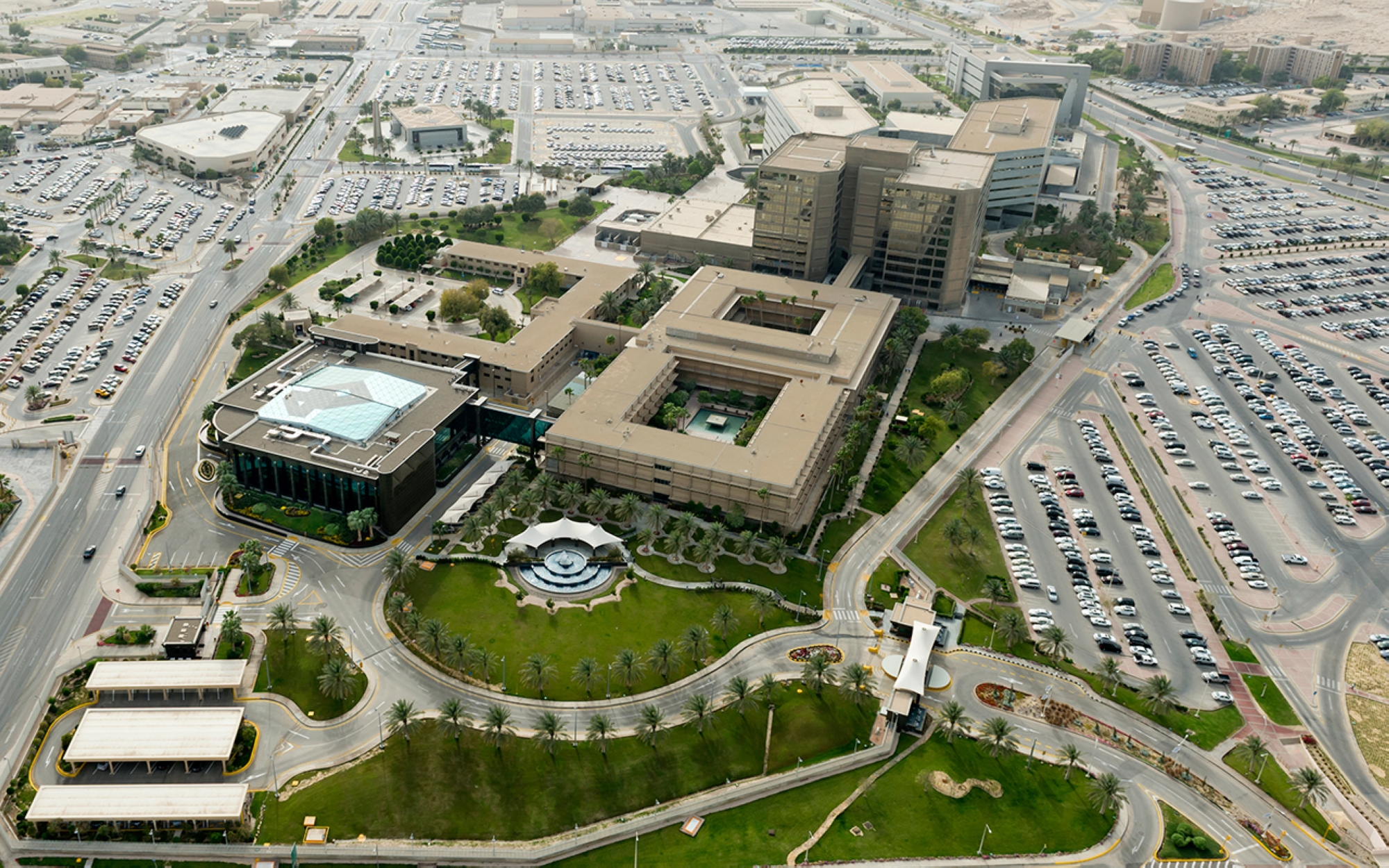
Dhahran City (Aẓ Ẓahrān) is an integral part of Dammam metropolitan area encompassing al-Khobar and Dammam. It is located in the Eastern Province, the largest region within the Kingdom of Saudi Arabia. The name 'Dhahran' originated from a prominent limestone mountain situated at its center, commonly referred to as 'Dhahir' in Arabic, which rises to approximately one hundred m. Despite its relatively small size, Dhahran is home to several significant institutions in the Kingdom. This includes the Saudi Arabian Oil Company (Aramco), a cornerstone of the Kingdom's economy, and King Fahd University of Petroleum and Minerals, the first university established in the Eastern Province. In 1938, the lands of Dhahran witnessed the pivotal discovery of commercially viable petroleum quantities in a well famously known as the Well of al-Khair.
Dhahran city is situated along the Arabian Gulf coast, positioned to the south of Dammam, which forms its northern and western borders and is approximately fifteen km away. Al-Khobar is located to its east and west, encompassing residential neighborhoods, e.g., al-Dana and al-Doha. It is now part of the Dammam metropolitan area, which also includes al-Khobar and Dammam.
Dhahran City Population
There are 143,936 people living in Dhahran city according to the Saudi Census 2022. Saudis are about 58.2 percent of the city's population with approximately 83,745 people.
Dhahran City Climate
The climate in the Eastern Province is relatively moderate. The weather is generally clear. However, between May and August, temperatures can reach up to forty-seven degrees Celsius with humidity. During the winter season, which extends from November to February, temperatures can drop to as low as eight degrees Celsius. Overall, rainfall amounts in Dhahran are characterized by fluctuations, ranging from light to sudden and heavy showers.
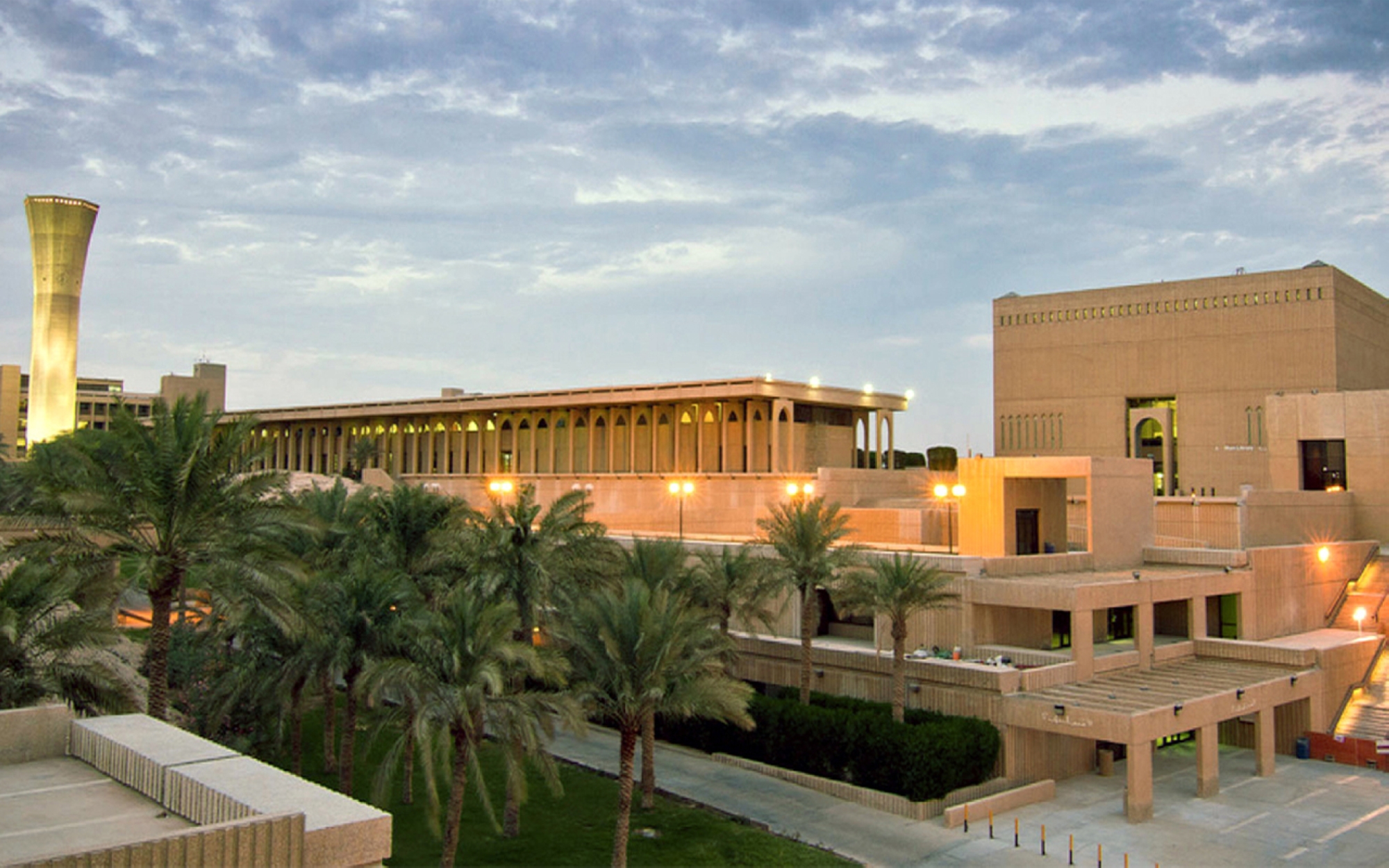
General Education in Dhahran City
General Education
General education began in the Eastern Region in general in 1941 when al-Ahsa Elementary School opened its new building. Schools were subsequently established, including schools with different specializations such as vocational, agricultural, technical, and public schools with three levels: Primary, Intermediate, and Secondary. In 1959, girls' schools began to open and spread throughout the cities of the Eastern Province.
In 1947, the Directorate of Education (currently the Ministry of Education) established a public school in Dhahran, dedicated to teaching oil industry workers. Following a comprehensive literacy eradication campaign that began in 1954, an evening school was opened. In its first year, it enrolled 318 students. By 1956, the number had increased to one thousand students. Then, in 1958, it expanded to six schools with twenty classrooms and around eight hundred students.
At present, according to the General Authority for Statistics report in 2017, the number of public schools in Dhahran for General education stages (Primary, Intermediate, and Secondary) is approximately fifty schools, including schools for males and others for females.
Higher Education in Dhahran City
King Fahd University of Petroleum and Minerals
Dhahran proudly hosts King Fahd University of Petroleum and Minerals, which holds the distinction of being the first university in the Eastern Province. Established on September 23, 1963, the institution initially commenced as a college before advancing to university status. The university offers a diverse range of disciplines across its various colleges, encompassing the College of Sciences, College of Engineering, College of Computer Sciences and Engineering, College of Petroleum Engineering and Geo-sciences, College of Environmental Design, College of Business, and College of General Studies.
It is noteworthy that in the 2023 QS World University Rankings, King Fahd University of Petroleum and Minerals achieved a remarkable fourth position globally in Petroleum Engineering and ninth in Mining and Minerals Engineering. These rankings, determined in the United Kingdom, evaluate universities in the Arab world based on six key criteria: academic reputation, staff reputation, international student ratio, international staff ratio, student-to-faculty ratio, and scientific citations.
Prince Sultan Military College of Health Sciences
Prince Sultan Military College of Health Sciences in Dhahran was established and opened on September 27, 1988. It is affiliated with the Ministry of Defense and was founded by the General Directorate of Medical Services for the Armed Forces and accredited by the Ministry of Higher Education. The college graduated qualified professionals to work in the medical facilities of the Armed Forces after completing ten semesters of study.
The college offers a range of programs, including Clinical Laboratory Sciences, Nursing, Emergency Medical Services, Dental Health and Care, Respiratory Care, Medical Equipment Technology, Anesthesia Technology, and Health Information Management.
The college includes a Simulation and Advanced Clinical Skills Center, which contributes to honing students' skills using modern techniques in healthcare simulation and virtual reality by working with internationally recognized practices and supporting the development of academic programs and scientific and community activities.
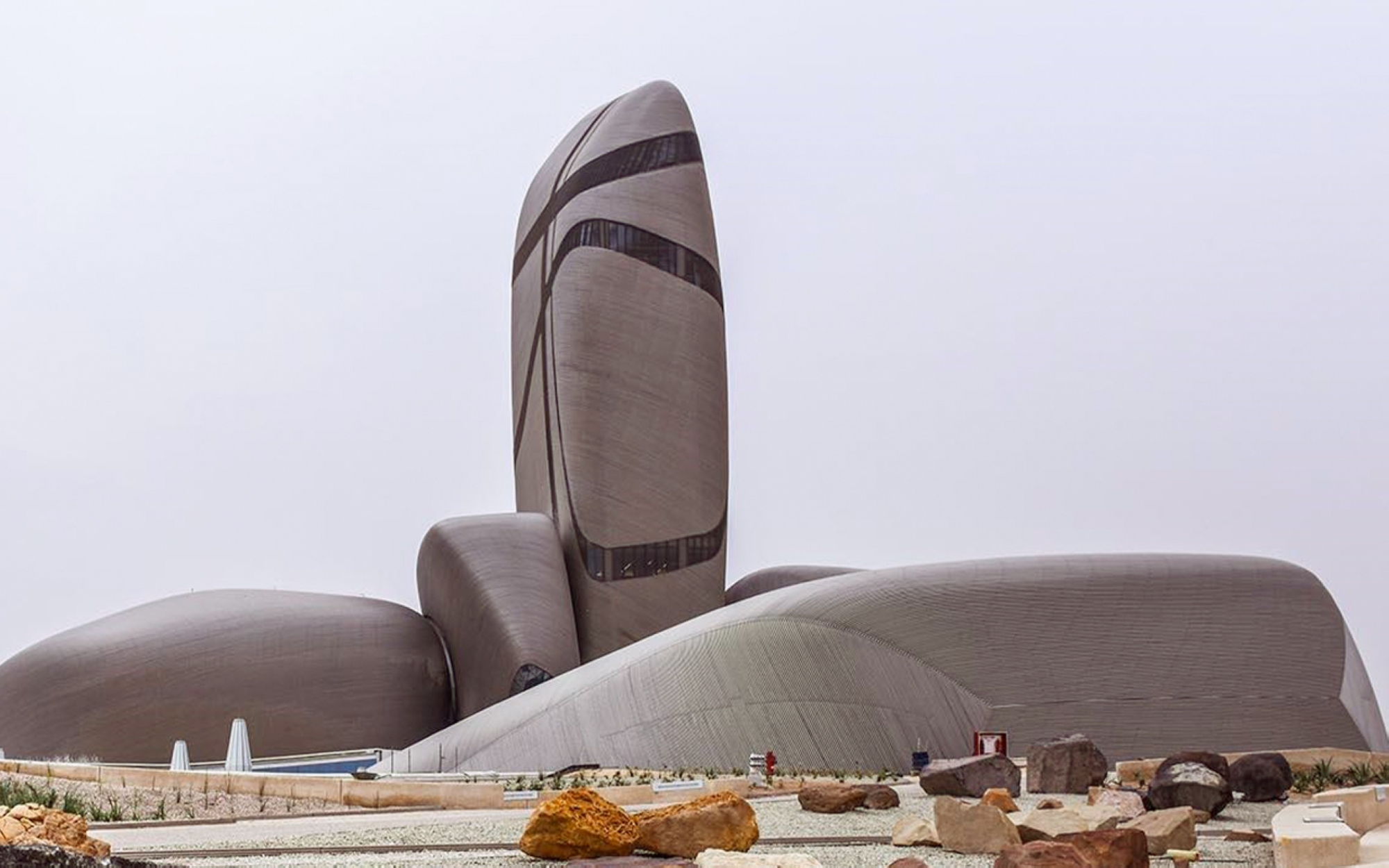
Cultural Movement in Dhahran City
King Abdulaziz Center for World Culture (Ithra)
King Abdulaziz Center for World Culture was established in Dhahran as one of the initiatives of Aramco to celebrate its seventy-fifth anniversary since its founding. Two kings of the Kingdom sponsored its establishment, as King Abdullah Bin Abdulaziz Al Saud laid its foundation in 2008, and it was later inaugurated by King Salman Bin Abdulaziz Al-Saud on December 1, 2016.
The center offers various initiatives and experiences at the local, regional, and international levels for visitors. It serves as a platform for local and global talents to come together for learning, cultural dissemination, and entertainment while also contributing to improving the quality of life in the community. It has been featured among the World's 100 Greatest Places in Time Magazine.
The center includes a four-story library, an eighteen-story Ithra Tower, the Energy Exhibit, a three-story Idea Lab, a museum with five exhibits, a children's museum, a theater with a capacity of nine hundred people, a cinema that can accommodate about three hundred people and a hall with an area of up to 1,500 m.
The center was built according to LEED International Standards (Leadership in Environmental Design and Energy). Designed by the Norwegian company Snøhetta, the center is shaped in the form of a group of interacting rocks of different sizes, each representing symbols. The underground floors include the archives and the museum, symbolizing the authenticity of the past. The ground level, where live performances take place, represents a symbol of the renaissance of the present. The upper floors represent the future.

Dhahran City Economy
Saudi Arabian Oil Company (Aramco)
Dhahran city is home to one of the world's largest energy and chemicals companies, Aramco, also known as the Saudi Arabian Oil Company. Aramco is a fundamental pillar of the Saudi economy and a significant source of income for the country. It owns eleven oil stations, including two marine stations in the Arabian Gulf: al-Zuluf and al-Safaniyah. The company boasts the largest conventional oil field in terms of proven reserves, and it operates the largest crude oil processing and concentration facility globally, located in Abqaiq. Additionally, Aramco has several gas processing plants situated throughout the Kingdom. It also engages in partnerships with nine global companies in the chemical industry for production collaboration.
Aramco's origins can be traced back to 1933 in Saudi Arabia when oil was discovered during the reign of the founding King Abdulaziz Bin Abdulrahman Al Saud. Saudi Arabia entered into a concession agreement with the American company SoCal. In 1938, commercial quantities of oil were discovered at Dammam Well No. 7, which was later named the Well of al-Khair. The first oil shipment took place in 1939, and following the discovery of the Abqaiq field in 1940, production doubled. The company steadily expanded and achieved remarkable milestones until its official establishment in 1988 through a Royal Decree issued by King Fahd Bin Abdulaziz Al Saud. At that time, ownership was transferred to the Saudi government, and the company's name was changed from the Arabian American Oil Company to the Saudi Arabian Oil Company. Today, Aramco remains an essential pillar of the Saudi economy, and it exports its refined products to approximately seventeen thousand stations worldwide. In the first quarter of 2023, the company generated a net income of approximately SAR119.5 Billion.
Dhahran Expo
Dhahran Expo is a joint-stock company in the Kingdom. It was established in 1985. The company specializes in organizing exhibitions and events across various sectors, particularly global economic events. It provides integrated services for its organization, including multiple visitor service facilities, including halls, a desk, a lobby, a mosque, parking lots, eight meeting rooms, fourteen reception areas, four VIP lounges, and three business centers.
Since its inception, the exhibition has attracted hundreds of exhibitors and thousands of visitors from around the world. It works in three areas, including hosting, organizing, managing, equipping, and covering all the requirements of events until their conclusion. It hosts consumer exhibitions, entertainment exhibitions, as well as commercial and specialized events. The events can be held at their headquarters in Dhahran, across the Kingdom in general, or even abroad.
Monuments in Dhahran City
Dhahran Cemeteries
The cemeteries in Dhahran have a rich history dating back to the third millennium BCE. They are situated within a triple burial site that encompasses around nine hundred cemeteries. It is important to note that some of the cemeteries in the area have been subjected to looting during different periods. The archaeological findings at the site include a variety of artifacts such as tools, pottery, ornaments, beads, and seals.
The settlement found in Dhahran encompasses three distinct periods, with the oldest dating back to the third century BCE. The second period spans from the beginning of the second century BCE until the end of the sixth century AD. Excavations revealed a diverse range of pottery styles within these settlements. These include jug-shaped and cylindrical pots, ribbed pots, barbarian pots, as well as a collection of sandy and burnt grey pots. Additionally, a large quantity of colored pottery was discovered. In addition to pottery, a collection of beads was unearthed at the site. These beads exhibit various shapes such as convex, spherical, cylindrical, conical, and hexagonal beads. Additionally, there were shell beads and beads of Chinese origin.
Related quizzes
Related articles

